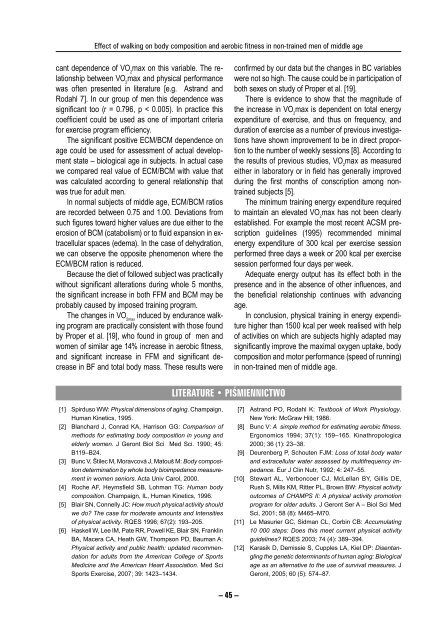Antropomotoryka nr 55.indb - Akademia Wychowania Fizycznego w ...
Antropomotoryka nr 55.indb - Akademia Wychowania Fizycznego w ...
Antropomotoryka nr 55.indb - Akademia Wychowania Fizycznego w ...
Create successful ePaper yourself
Turn your PDF publications into a flip-book with our unique Google optimized e-Paper software.
Effect of walking on body composition and aerobic fitness in non-trained men of middle age<br />
cant dependence of VO 2<br />
max on this variable. The relationship<br />
between VO 2<br />
max and physical performance<br />
was often presented in literature [e.g. Astrand and<br />
Rodahl 7]. In our group of men this dependence was<br />
significant too (r = 0.796, p < 0.005). In practice this<br />
coefficient could be used as one of important criteria<br />
for exercise program efficiency.<br />
The significant positive ECM/BCM dependence on<br />
age could be used for assessment of actual development<br />
state – biological age in subjects. In actual case<br />
we compared real value of ECM/BCM with value that<br />
was calculated according to general relationship that<br />
was true for adult men.<br />
In normal subjects of middle age, ECM/BCM ratios<br />
are recorded between 0.75 and 1.00. Deviations from<br />
such figures toward higher values are due either to the<br />
erosion of BCM (catabolism) or to fluid expansion in extracellular<br />
spaces (edema). In the case of dehydration,<br />
we can observe the opposite phenomenon where the<br />
ECM/BCM ration is reduced.<br />
Because the diet of followed subject was practically<br />
without significant alterations during whole 5 months,<br />
the significant increase in both FFM and BCM may be<br />
probably caused by imposed training program.<br />
The changes in VO 2max<br />
induced by endurance walking<br />
program are practically consistent with those found<br />
by Proper et al. [19], who found in group of men and<br />
women of similar age 14% increase in aerobic fitness,<br />
and significant increase in FFM and significant decrease<br />
in BF and total body mass. These results were<br />
confirmed by our data but the changes in BC variables<br />
were not so high. The cause could be in participation of<br />
both sexes on study of Proper et al. [19].<br />
There is evidence to show that the magnitude of<br />
the increase in VO 2<br />
max is dependent on total energy<br />
expenditure of exercise, and thus on frequency, and<br />
duration of exercise as a number of previous investigations<br />
have shown improvement to be in direct proportion<br />
to the number of weekly sessions [8]. According to<br />
the results of previous studies, VO 2<br />
max as measured<br />
either in laboratory or in field has generally improved<br />
during the first months of conscription among nontrained<br />
subjects [5].<br />
The minimum training energy expenditure required<br />
to maintain an elevated VO 2<br />
max has not been clearly<br />
established. For example the most recent ACSM prescription<br />
guidelines (1995) recommended minimal<br />
energy expenditure of 300 kcal per exercise session<br />
performed three days a week or 200 kcal per exercise<br />
session performed four days per week.<br />
Adequate energy output has its effect both in the<br />
presence and in the absence of other influences, and<br />
the beneficial relationship continues with advancing<br />
age.<br />
In conclusion, physical training in energy expenditure<br />
higher than 1500 kcal per week realised with help<br />
of activities on which are subjects highly adapted may<br />
significantly improve the maximal oxygen uptake, body<br />
composition and motor performance (speed of running)<br />
in non-trained men of middle age.<br />
LITERATURE • PIŚMIENNICTWO<br />
[1] Spirduso WW: Physical dimensions of aging. Champaign,<br />
Human Kinetics, 1995.<br />
[2] Blanchard J, Co<strong>nr</strong>ad KA, Harrison GG: Comparison of<br />
methods for estimating body composition in young and<br />
elderly women. J Geront Biol Sci Med Sci. 1990; 45:<br />
B119–B24.<br />
[3] Bunc V, Štilec M, Moravcová J, Matouš M: Body composition<br />
determination by whole body bioimpedance measurement<br />
in women seniors. Acta Univ Carol, 2000.<br />
[4] Roche AF, Heymsfi eld SB, Lohman TG: Human body<br />
composition. Champaign, IL, Human Kinetics, 1996.<br />
[5] Blair SN, Connelly JC: How much physical activity should<br />
we do? The case for moderate amounts and Intensities<br />
of physical activity. RQES 1996; 67(2): 193–205.<br />
[6] Haskell W, Lee IM, Pate RR, Powell KE, Blair SN, Franklin<br />
BA, Macera CA, Heath GW, Thompson PD, Bauman A:<br />
Physical activity and public health: updated recommendation<br />
for adults from the American College of Sports<br />
Medicine and the American Heart Association. Med Sci<br />
Sports Exercise, 2007; 39: 1423–1434.<br />
[7] Astrand PO, Rodahl K: Textbook of Work Physiology.<br />
New York: McGraw Hill; 1986.<br />
[8] Bunc V: A simple method for estimating aerobic fi tness.<br />
Ergonomics 1994; 37(1): 159–165. Kinathropologica<br />
2000; 36 (1): 23–38.<br />
[9] Deurenberg P, Schouten FJM: Loss of total body water<br />
and extracellular water assessed by multifrequency impedance.<br />
Eur J Clin Nutr, 1992; 4: 247–55.<br />
[10] Stewart AL, Verboncoer CJ, McLellan BY, Gillis DE,<br />
Rush S, Mills KM, Ritter PL, Brown BW: Physical activity<br />
outcomes of CHAMPS II: A physical activity promotion<br />
program for older adults. J Geront Ser A – Biol Sci Med<br />
Sci, 2001; 58 (8): M465–M70.<br />
[11] Le Masurier GC, Sidman CL, Corbin CB: Accumulating<br />
10 000 steps: Does this meet current physical activity<br />
guidelines? RQES 2003; 74 (4): 389–394.<br />
[12] Karasik D, Demissie S, Cupples LA, Kiel DP: Disentangling<br />
the genetic determinants of human aging: Biological<br />
age as an alternative to the use of survival measures. J<br />
Geront, 2005; 60 (5): 574–87.<br />
– 45 –





![Antropomotoryka nr 57 [2012]. - Akademia Wychowania Fizycznego ...](https://img.yumpu.com/50213388/1/182x260/antropomotoryka-nr-57-2012-akademia-wychowania-fizycznego-.jpg?quality=85)











